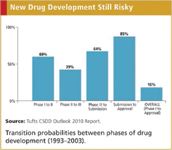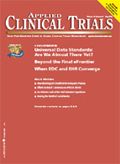Drug Success Rates Remain Low
Applied Clinical Trials
It now costs more than $1 billion and takes more than seven years, on average, to conduct clinical trials and win regulatory approval to market a new drug. Not only are development costs high and rising steadily, but also only one out of every six self-originated drugs developed successfully completes clinical testing and obtains marketing approval.
It now costs more than $1 billion and takes more than seven years, on average, to conduct clinical trials and win regulatory approval to market a new drug. Not only are development costs high and rising steadily, but also only one out of every six self-originated drugs developed successfully completes clinical testing and obtains marketing approval.

New Drug Development Still Risky
This 16% overall success rate—gleaned from the portfolios of the top 50 largest global pharmaceutical companies—has remained relatively constant despite efforts on the part of sponsors to improve the overall quality, predictability, and scope of their clinical research data. Although overall success rates have not changed substantially during the past decade, some trends in phase transition probabilities have been observed: Clinical transition probabilities between Phase i and Phase II and between Phase II and Phase III have gotten lower, suggesting that drug sponsors are becoming more aggressive about terminating unpromising candidates, enabling them to redirect increasingly scarce R&D resources to more promising drug development programs.—Tufts Center for Drug Development, http://csdd.tufts.edu.

Improving Relationships and Diversifying the Site Selection Process
April 17th 2025In this episode of the Applied Clinical Trials Podcast, Liz Beatty, co-founder and chief strategy officer, Inato, discusses a number of topics around site engagement including community-based sites, the role of technology in improving site/sponsor relationships, how increased operational costs are impacting the industry, and more.
Behind the Buzz: Why Clinical Research Leaders Flock to SCOPE Summit
February 7th 2025In this episode, we meet with Micah Lieberman, Executive Conference Director for SCOPE Summit (Summit for Clinical Ops Executives) at Cambridge Innovation Institute. We will dive deep into the critical role of collaboration within the clinical research ecosystem. How do we bring together diverse stakeholders—sponsors, CROs, clinical trial tech innovators, suppliers, patients, sites, advocacy organizations, investors, and non-profits—to share best practices in trial design, program planning, innovation, and clinical operations? We’ll explore why it’s vital for thought leaders to step beyond their own organizations and learn from others, exchanging ideas that drive advancements in clinical research. Additionally, we’ll discuss the pivotal role of scientific conferences like SCOPE Summit in fostering these essential connections and collaborations, helping shape the future of clinical trials. Join us as we uncover how collective wisdom and cross-industry partnerships are transforming the landscape of clinical research.